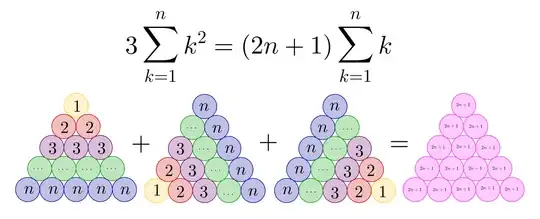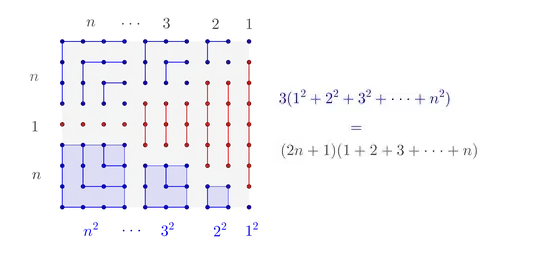$\newcommand{\bbx}[1]{\,\bbox[15px,border:1px groove navy]{\displaystyle{#1}}\,}
\newcommand{\braces}[1]{\left\lbrace\,{#1}\,\right\rbrace}
\newcommand{\bracks}[1]{\left\lbrack\,{#1}\,\right\rbrack}
\newcommand{\dd}{\mathrm{d}}
\newcommand{\ds}[1]{\displaystyle{#1}}
\newcommand{\expo}[1]{\,\mathrm{e}^{#1}\,}
\newcommand{\ic}{\mathrm{i}}
\newcommand{\mc}[1]{\mathcal{#1}}
\newcommand{\mrm}[1]{\mathrm{#1}}
\newcommand{\pars}[1]{\left(\,{#1}\,\right)}
\newcommand{\partiald}[3][]{\frac{\partial^{#1} #2}{\partial #3^{#1}}}
\newcommand{\root}[2][]{\,\sqrt[#1]{\,{#2}\,}\,}
\newcommand{\totald}[3][]{\frac{\mathrm{d}^{#1} #2}{\mathrm{d} #3^{#1}}}
\newcommand{\verts}[1]{\left\vert\,{#1}\,\right\vert}$
Note that $\ds{k^{\underline{1}} = k}$ and
$\ds{k^{\underline{2}} = k\pars{k -1} = k^{2} - k^{\underline{1}}}$ such that $\ds{k^{2} = k^{\underline{2}} + k^{\underline{1}}}$. Then,
\begin{align}
\sum_{k = 1}^{n}k^{2} & =
\sum_{k = 0}^{n}\pars{k^{\underline{2}} + k^{\underline{1}}} =
\pars{{1 \over 3}\,k^{\underline{3}} + {1 \over 2}\,k^{\underline{2}}}_{\ k\ =\ n +1}
\\[5mm] & =
{1 \over 3}\,\pars{n + 1}^{\,\underline{3}} +
{1 \over 2}\,\pars{n + 1}^{\,\underline{2}}
\\[5mm] & =
{1 \over 3}\pars{n + 1}n\pars{n - 1} + {1 \over 2}\pars{n + 1}n
\\[5mm] & =
n\pars{n + 1}\bracks{{1 \over 3}\pars{n - 1} + {1 \over 2}} =
\bbx{n\pars{n + 1}\pars{2n + 1} \over 6}
\end{align}
See Section
${\bf 2.6}$ $\ds{\pars{\bf\mbox{FINITE AND INFINITE CALCULUS}}}$ in
Concrete Mathematics by
$\mbox{R. L. Graham}$, D. E. Knuth and
O. Patashnik,
$\ds{2^{\underline{nd}}}$ ed., Addison Wesley Publishing Company.

